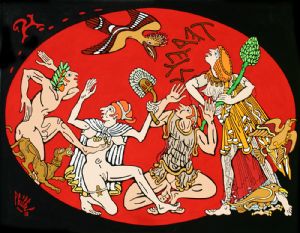| |

|

|
E75 - THE RETURN OF TEREUS - 2007
Painting Acrylic
Size: - 55,1 x 74,8 inches
16800 USD
Description:
ETRUSCAN / Acrylic on canvas 140 x 190 cm. - 55,1 x 74,8 inches / (Text translated by Google) / Tereus is part of Greek mythology, not to be confused with Theseus, legendary king of Athens, much more often cited than the last! Tereus is still a hero of a popular legend in which the characters are borrowed from the world of birds. Procne and Philomela (the nightingale and swallow) are the daughters of King Pandion of Athens. Tereus, king of Thrace, and son of Ares is none other than the hoopoe (gr.: epops -lat.: upapa). The crest is the enemy of the swallow and the nightingale, the more it was considered unclean bird by the Greeks, mostly because it also feeds on larvae extracts of feces! Pandion had Tereus patron and gave him his daughter in marriage Procne, but the barbarian king takes more his step-sister Philomela and rapes. He cut off his tongue so it can not betray him. But the latter, because writing did not exist at that time, weaves a fabric whose patterns tell his misadventure. Procne come to light, and together the two sisters get together to punish Tereus by serving in a meal, members of Itys, the child of five years he had been Procne. To punish the three protagonists are all guilty, the gods change them into birds. Since then, they say, the swallows do not know how to sing, they chirp. Greek poetry is filled with allusions to this story: Tereus is sometimes changed to hawk or vulture! Sophocles fired a tragedy, now lost, but were said to be among its best! This table shows continuing to pursue Procne Tereus Philomela and protected by their faithful excited! Among the representations on this subject from Ovid's Metamorphoses:
1 Bernard Solomons in 1557 in Lyon: Tereus violates Philomela, woodcuts preserved in the Central Library of Montpellier, Rating C189, funds Cavalier.
2 Pablo Picasso, undated: Fight between Tereus and Philomela, this engraving of the Franklin Bowles Gallery in San Francisco, baer 154 bloch 110.
Of the four people present on the table: Left: initially it was a satyr with black figures. Middle left: The woman, one knee on earth was almost raped Cassandra (present in a penthouse hydria 490 BC.) Middle right: the kneeling man was originally an Egyptian slave, with shaven heads and Negroid features, circumcised and beaten by Heracles in battle against the servants of Busiris, hence its ambiguity arises from a painting in red figures on vases by the Painter pelike Pan 470 BC. Right: the woman is a visible Maenad Antikensammlungen Munich, No. 2344. The dog is in the usual dogs raised by the Etruscan artist. Letters: Tereus in the table are in line with Etruscan writing, either boustrophedon: from right to left on the front row, from left to right if there is a next row and so on. The monogram and signature Philhelm round off the work.
Maenad: woman possessed, worshiper of Dionysus, who personifies the spirit of orgiastic nature.
|
|

|
|